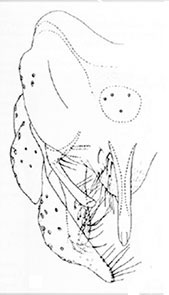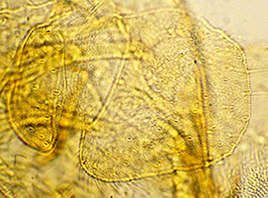Species 2z. C. harpi Sublette, 1991The nearest neighbor in BOLD is BOLD:AAG5472 an unidentified species mainly from central and western North America Adult: Wing length 3.20 (2.63-3.67) mm.; VR 0.99; r-m crossvein darkened; 26 (23-41) setae in squamal fringe. Head: AR 3.88 (3.69-4.32); frontal tubercle 15-31 µm; clypeus 0.75 width of ant. pedicel, with 32 (28-40) setae; palpal proportions (segs 2-5) 55 : 195 : 234 : 234. Thorax with small but distinct mesonotal tubercle. Setae: Acrostichal - 19 (16-20); Dorsolateral - 25 (21-30); Prealar - 5 (4-6); Supraalar - 1; and Scutellar - 29 (23-39). Leg ratios: PI 1.39 (1.33-1.43); PII 0.59 (0.57-0.62); PIII 0.72 (0.71-0.73); BR 3.36 (2.2-4.67). Setae on TIX 4 (2-9); Superior volsella long, narrow and blunt tipped, closest to E(g)-type of Strenzke (1959); Inferior volsella reaching to about end of anal point and about 2/3 along the gonostylus, which is quite swollen and narrows sharply about posterior third.  Male hypopygium (from Wülker et al. 1991). Female: Coloration as in males but coloration darker, legs blackish. Genitalia of the allotype female, illustrated in Wülker et al. (1991), shows only the labium and ventrolateral lobe. From other females, segment X wider than usual for a greater part of the length (see figure below), dorsal end hard to see, about 4.75 times longer than its greatest width with 11-18 setae; the cercus has the dorsal margin slightly shorter than the ventral margin which has a basal bulge, so that the dorsal margin is longer than that somewhat rounded ventral margin.  Female cercus (right) with segment X (left). See Pupa, Fourth instar larva and Cytology Found: Ontario - Point Pelee National Park (41.959°N, 82.518°W) (NCBI) Pools with low pH. Morphology of all life stages, and cytology described by Wülker, Sublette & Martin (1991). Some ecological data given by Harp and Campbell (1973), as C. plumosus; Harp and Hubbard (1972), as C. n.sp. and Bates and Stahl (1985), as C. nr. maturus. The South Dakota population may represent a distinct species, however more samples are required to clarify this. In the mean time it is assumed that this is just geographic differentiation. Molecular Data |
Modified: 26 September 2021
Access: Unrestricted
Copyright © 2000-2021, Jon Martin.